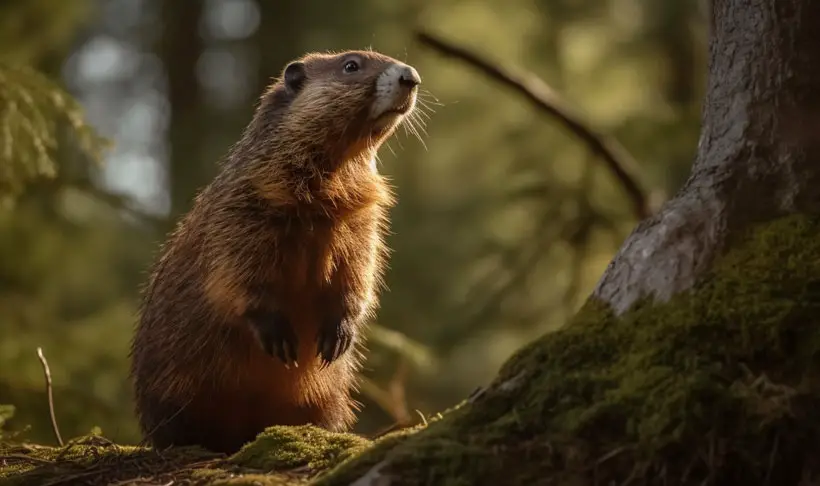Do Marmots Climb Trees? Understanding Marmot Behavior and Habitat
Marmots are among the largest members of rodents, found under the family Sciuridae. They have large heads, stout bodies, short but strong hind legs, and enlarged claws on their forelimbs.
They are found in North America, Asia, Europe, and northern Mexico on mountains, plains, and forest edges. It’s crucial to understand marmots’ habitats and behaviors to understand them better and the type of environment they prefer.
The article covers marmots’ climbing behavior and habitats and should help you answer the question, “Do marmots climb trees?” So read on for more thrilling details.
Can Marmots Climb Trees?
Yes, Marmots can climb trees, which is expected given that some marmot species live on forest edges. There are Observations of these rodents hopping on a tree and racing upward as squirrels do.
However, they are terrestrial and spend most of their time on the ground, where they burrow. Marmot’s climbing behavior is often not permanent and must be for a reason. Most of the wildlife photography on these mammals features them on the ground rather than in the trees.

Marmot adaptations that contribute to their ability to climb are their sharp claws, especially on the forelimbs. While they’re mainly used for burrowing under the ground, they also prove helpful in climbing trees. The rodents also use their strong hindlimbs to push their bodies upwards when climbing.
Other than trees, the mountain ecology provides other things like rocks, shrubs, and bushes, all of which the marmots climb. Their close relatives, groundhogs, are also known to climb most man-made structures, like fences and pillars.
Situations in Which Marmots May Climb Trees
As said earlier, these rodents mostly climb for reasons, as it’s hard to come across a marmot tree habitat. However, this doesn’t mean there are not, as some can burrow near a tree.

However, some of the reasons that marmots climb trees are given below.
- For leaves: Some of the reasons a marmot may climb a tree include eating leaves, which are among the plants they eat. The scenario often happens when the vegetation on the ground level is almost depleted, leaving the trees as their only option.
- For insects: Also, some species, like the yellow-bellied marmot, occasionally eat insects, like grasshoppers, for survival. When running after these insects, they may climb on trees to get them.
- For getting bird eggs: Marmots also eat bird eggs and may climb the trees in search of some.
- Escaping from the predators: Another possible reason they may climb a tree is when running from predators, and they cannot run back to their burrows and hide. Their predators, which include foxes and coyotes, can easily outrun them if they don’t take shelter soon.
However, marmots are not excellent climbers and are slower than tree-dwelling rodents. This is a disadvantage, for instance, when running from a predator, like a badger which can also climb. Their stout bodies are also not well adapted for climbing trees.
Where Do Marmots Prefer to Live?
Marmot habitat preferences are mountain slopes, plains, tundra, steppes, and mountains, where they dig their burrows and live. These places are often near vegetation where they can get a variety of plants they survive on.
One of the reasons they prefer the sloppy mountains is for better lookouts on the predators. On the slopes, they, however, build a system of burrows, where they run into if they spot a predator. These systems have several entrances and exits, which allows them more chances of escape.

Some species, like the hoary marmots, are found in the rocky outcrops and alpine tundra. These rocky nature parts provide them better protection from predators like grizzly bears. These predators can dig them out if it is not for the rocks by their entrances.
Also, the rocky outcrops allow them better surveillance of any incoming threat, including birds of prey from the skies. When they spot a predator, they whistle sharply and loudly, which alerts all their family members nearby to hide.
Most marmots live in warm places where winter doesn’t last long, and plants are plenty most times of the year. Plenty of vegetation is crucial since they survive on their body fats and water during winter, which they accumulate over the year.
However, some species live in cold places where the weather is extreme and winters last longer. The Alpine marmots are among these species living in cold high mountains, 2,600 and 10,500 feet in the Alps.
How Do Habitats Affect Marmots Behavior?
Habitats affect marmots’ behaviors in many ways. For one, they must dig burrows in their mountain habitats to have more leverage over the predators.
Their mammal behaviors allow them to live in family groups of as many as 20 individuals. They depend on each other, like when one keeps a lookout while others feed or groom. However, marmots are monogamous, and offspring can be as many as 15 in a family group.

The high number of members is helpful when winter comes. After they retreat into their burrows, they keep each other warm as they hibernate. However, their body temperatures drop when hibernating, which is an evolutionary adaptation to minimize energy use.
Also, when there is a shortage of vegetation in their wildlife habitats, their wildlife behaviors change. They adapt by climbing on trees to eat leaves from them.
Marmots are known for their impressive climbing skills, but did you know they’re also great swimmers? These furry creatures are equally at home on land and in the water, which is just one of the reasons they’re so fascinating. If you’re interested in learning more about marmots, you might also want to check out our article on marmots vs. ferrets, which explores the similarities and differences between these two animals. And if you’re curious about marmot swimming abilities, our article on do marmots swim? has all the information you need.Conclusion
Other than answering the question, “do marmots climb trees?” the article also exhaustively discusses marmot behaviors and habitats. Some points to note include the following;
- Marmots can climb trees, which they do to feed or get away from predators.
- However, marmots are not good climbers and prefer burrowing under the ground on mountain slopes.
- Their behaviors are affected by their habitats, as in the instances with the tree climbing.
Understanding their behaviors and habitats is crucial as it helps when studying their habits and characteristics. The study also helps scientists know how to better their environments, minimize threats, and design nature preserves for them.
Do more research about marmots to learn more about their habitats and behaviors.




